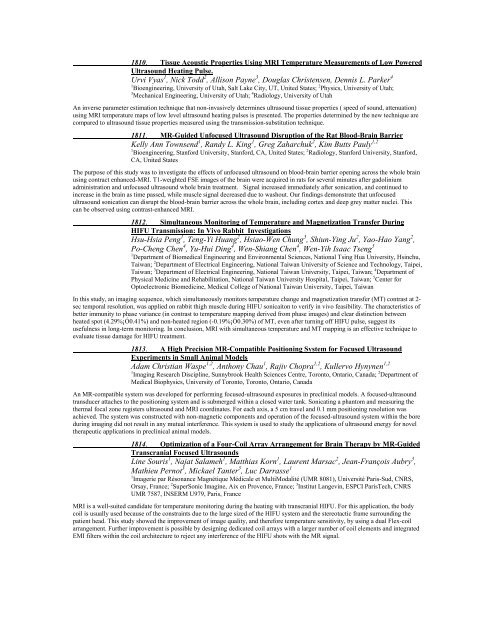Traditional Posters: Interventional - ismrm
Traditional Posters: Interventional - ismrm
Traditional Posters: Interventional - ismrm
Create successful ePaper yourself
Turn your PDF publications into a flip-book with our unique Google optimized e-Paper software.
1810. Tissue Acoustic Properties Using MRI Temperature Measurements of Low Powered<br />
Ultrasound Heating Pulse.<br />
Urvi Vyas 1 , Nick Todd 2 , Allison Payne 3 , Douglas Christensen, Dennis L. Parker 4<br />
1 Bioengineering, University of Utah, Salt Lake City, UT, United States; 2 Physics, University of Utah;<br />
3 Mechanical Engineering, University of Utah; 4 Radiology, University of Utah<br />
An inverse parameter estimation technique that non-invasively determines ultrasound tissue properties ( speed of sound, attenuation)<br />
using MRI temperature maps of low level ultrasound heating pulses is presented. The properties determined by the new technique are<br />
compared to ultrasound tissue properties measured using the transmission-substitution technique.<br />
1811. MR-Guided Unfocused Ultrasound Disruption of the Rat Blood-Brain Barrier<br />
Kelly Ann Townsend 1 , Randy L. King 1 , Greg Zaharchuk 2 , Kim Butts Pauly 1,2<br />
1 Bioengineering, Stanford University, Stanford, CA, United States; 2 Radiology, Stanford University, Stanford,<br />
CA, United States<br />
The purpose of this study was to investigate the effects of unfocused ultrasound on blood-brain barrier opening across the whole brain<br />
using contract enhanced-MRI. T1-weighted FSE images of the brain were acquired in rats for several minutes after gadolinium<br />
administration and unfocused ultrasound whole brain treatment. Signal increased immediately after sonication, and continued to<br />
increase in the brain as time passed, while muscle signal decreased due to washout. Our findings demonstrate that unfocused<br />
ultrasound sonication can disrupt the blood-brain barrier across the whole brain, including cortex and deep grey matter nuclei. This<br />
can be observed using contrast-enhanced MRI.<br />
1812. Simultaneous Monitoring of Temperature and Magnetization Transfer During<br />
HIFU Transmission: In Vivo Rabbit Investigations<br />
Hsu-Hsia Peng 1 , Teng-Yi Huang 2 , Hsiao-Wen Chung 3 , Shiun-Ying Ju 2 , Yao-Hao Yang 2 ,<br />
Po-Cheng Chen 4 , Yu-Hui Ding 4 , Wen-Shiang Chen 4 , Wen-Yih Isaac Tseng 5<br />
1 Department of Biomedical Engineering and Environmental Sciences, National Tsing Hua University, Hsinchu,<br />
Taiwan; 2 Department of Electrical Engineering, National Taiwan University of Science and Technology, Taipei,<br />
Taiwan; 3 Department of Electrical Engineering, National Taiwan University, Taipei, Taiwan; 4 Department of<br />
Physical Medicine and Rehabilitation, National Taiwan University Hospital, Taipei, Taiwan; 5 Center for<br />
Optoelectronic Biomedicine, Medical College of National Taiwan University, Taipei, Taiwan<br />
In this study, an imaging sequence, which simultaneously monitors temperature change and magnetization transfer (MT) contrast at 2-<br />
sec temporal resolution, was applied on rabbit thigh muscle during HIFU sonicaiton to verify in vivo feasibility. The characteristics of<br />
better immunity to phase variance (in contrast to temperature mapping derived from phase images) and clear distinction between<br />
heated spot (4.29%¡Ó0.41%) and non-heated region (-0.19%¡Ó0.30%) of MT, even after turning off HIFU pulse, suggest its<br />
usefulness in long-term monitoring. In conclusion, MRI with simultaneous temperature and MT mapping is an effective technique to<br />
evaluate tissue damage for HIFU treatment.<br />
1813. A High Precision MR-Compatible Positioning System for Focused Ultrasound<br />
Experiments in Small Animal Models<br />
Adam Christian Waspe 1,2 , Anthony Chau 1 , Rajiv Chopra 1,2 , Kullervo Hynynen 1,2<br />
1 Imaging Research Discipline, Sunnybrook Health Sciences Centre, Toronto, Ontario, Canada; 2 Department of<br />
Medical Biophysics, University of Toronto, Toronto, Ontario, Canada<br />
An MR-compatible system was developed for performing focused-ultrasound exposures in preclinical models. A focused-ultrasound<br />
transducer attaches to the positioning system and is submerged within a closed water tank. Sonicating a phantom and measuring the<br />
thermal focal zone registers ultrasound and MRI coordinates. For each axis, a 5 cm travel and 0.1 mm positioning resolution was<br />
achieved. The system was constructed with non-magnetic components and operation of the focused-ultrasound system within the bore<br />
during imaging did not result in any mutual interference. This system is used to study the applications of ultrasound energy for novel<br />
therapeutic applications in preclinical animal models.<br />
1814. Optimization of a Four-Coil Array Arrangement for Brain Therapy by MR-Guided<br />
Transcranial Focused Ultrasounds<br />
Line Souris 1 , Najat Salameh 1 , Matthias Korn 1 , Laurent Marsac 2 , Jean-François Aubry 3 ,<br />
Mathieu Pernot 3 , Mickael Tanter 3 , Luc Darrasse 1<br />
1 Imagerie par Résonance Magnétique Médicale et MultiModalité (UMR 8081), Université Paris-Sud, CNRS,<br />
Orsay, France; 2 SuperSonic Imagine, Aix en Provence, France; 3 Institut Langevin, ESPCI ParisTech, CNRS<br />
UMR 7587, INSERM U979, Paris, France<br />
MRI is a well-suited candidate for temperature monitoring during the heating with transcranial HIFU. For this application, the body<br />
coil is usually used because of the constraints due to the large sized of the HIFU system and the stereotactic frame surrounding the<br />
patient head. This study showed the improvement of image quality, and therefore temperature sensitivity, by using a dual Flex-coil<br />
arrangement. Further improvement is possible by designing dedicated coil arrays with a larger number of coil elements and integrated<br />
EMI filters within the coil architecture to reject any interference of the HIFU shots with the MR signal.















